30.12.19
Douglas Laing & Co. Ltd. – Delightful & Delicious
The “delightful” is the company and the “delicious” is the whisky, just to avoid confusion. For the end of the year (where did it go?!) it’s the second in my series of interviews at independent, smaller companies. This time it’s the turn of Douglas Laing & Co. Ltd. which has been around for just over 70 years. This one, too, is family owned and run, with decades of good industry experience and expertise behind it though the team is relatively young. The owners are highly skilled at blending regional malts and malts + grains, though they do have ranges of single malts and single cask offerings too. It’s an enviable whisky repertoire with their brands selling in over 50 countries.
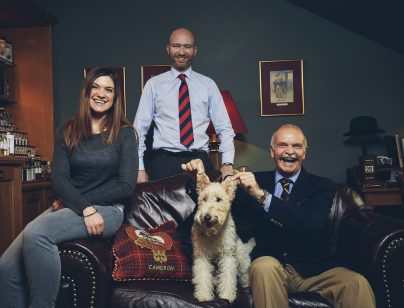
The company is headed up by Fred Laing, Chairman, with whom I met up on a dank day earlier this month and whom I used to see, occasionally, in the ferry queue for Islay. Other directors are Cara Laing (Fred’s daughter, whom I have interviewed in the past) who is now Director of Whisky and son-in-law Chris Leggat who came in as Head of Commercial and is now CEO. Cara also started out in a different role within the company. Sadly, they were not available when I visited but Fred is such a mine of information and a delight to interview. Cara and I caught up in correspondence afterwards.
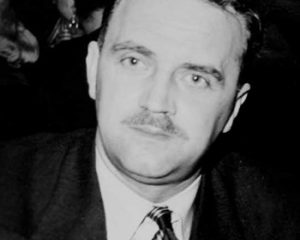 Looking at the Douglas Laing website, it looks as though Fred’s father, who founded the company in 1948, went straight from being in the Royal Air Force during WWII to running a whisky company. However, it’s not that simple. Apparently Fred Laing senior was working in shipping and logistics before joining the RAF. An American contact wanted a “Man Friday in Scotland”, as the current Fred Laing puts it, to take care of business for their King of Scots brand after the war so he began in 1946.
Looking at the Douglas Laing website, it looks as though Fred’s father, who founded the company in 1948, went straight from being in the Royal Air Force during WWII to running a whisky company. However, it’s not that simple. Apparently Fred Laing senior was working in shipping and logistics before joining the RAF. An American contact wanted a “Man Friday in Scotland”, as the current Fred Laing puts it, to take care of business for their King of Scots brand after the war so he began in 1946.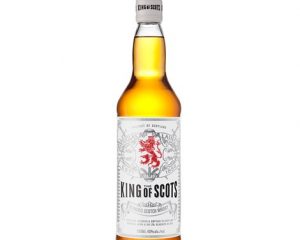
Stocks ran out in 1948 so the owners sold Fred the brand and the few remaining casks for a tiny amount. King of Scots is not a familiar one to me but Fred advises it’s been undervalued for a while and “left a little fallow.” It does well in Russia, the USA and some European countries but there are intentions to give it some more attention and a higher profile in future. The brand has existed since 1886, despite changes in ownership and the recipe remains much the same. Some time later, the McGibbon range (from his wife’s maiden name) was created. The McGibbon’s Golf range still sells well in the Far East. It comes in golf-themed packaging (what else?) which relaunched the brand in 2014 when the Ryder Cup came to Scotland at Gleneagles.
Young Fred went into the industry straight after school. He tells of the family being on holiday when he was 4 or 5 and a couple asked him what he was going to do when he grew up. He replied he was going into whisky, which rather surprised them. “Not the usual response”, says Fred now. His father took him out of school aged 16 to travel with him in South America where he perfected his skills in Spanish. Indeed, he was a talented linguist at school studying French, German and Spanish so his headmaster was most vexed that he was not pursuing his language studies at university. However, Fred’s father had detected what Fred calls “an inherent young man of commerce in there” and adds, “I learned my Japanese later.” Didn’t lose the love of language learning, then. Fred (senior), however, was not about to let his son loose in the family business without gaining experience elsewhere, famously saying that he could make mistakes with others first. This led to Fred getting a job with Whyte & Mackay in the late 1960’s where he was a followed at a later date by renowned master blender, Richard Paterson though not as a replacement for Fred (their fathers had worked together in the 50’s and 60’s). There Fred spent time with Major Hartley Whyte – who passed on his interest and delight in blending – a man of colourful personality, whom Fred reckons would be a social media star today. This was followed by a stint at White Horse Distillers, now part of Diageo.

This interested me as Fred’s daughter, Cara, followed a similar path and she did go to university, though it was to pursue marketing and  business studies and not with a view to coming into the family firm. She started working life in a marketing and design agency in Edinburgh but didn’t enjoy being on the supplier side. A friend told her Whyte & Mackay were recruiting and as Fred puts it, “She applied and got the job despite her name.” This is where I first encountered her. Another, more senior marketing position with Morrison Bowmore followed a few years later where our paths crossed occasionally and where she stayed until she joined the family company in 2013. Both Cara and Chris joined the Douglas Laing company from Morrison Bowmore and Fred tells that, with Cara’s marketing expertise, that side of the business and the increased industry usage of social media became much more important to them. Indeed they are good to follow on Twitter and Instagram. Anything Fred had done in marketing years before was gut instinct (no training) and his father, not long out of the war, disapproved of point of sale materials as “propaganda”. It was some time before the younger Fred was allowed to introduce any brand materials to promote their products. Ashtrays were frowned upon as Fred senior didn’t like cigarette butts covering their brand name. I’d say how things change but given the indoor smoking bans these days, there may be others who now feel the same.
business studies and not with a view to coming into the family firm. She started working life in a marketing and design agency in Edinburgh but didn’t enjoy being on the supplier side. A friend told her Whyte & Mackay were recruiting and as Fred puts it, “She applied and got the job despite her name.” This is where I first encountered her. Another, more senior marketing position with Morrison Bowmore followed a few years later where our paths crossed occasionally and where she stayed until she joined the family company in 2013. Both Cara and Chris joined the Douglas Laing company from Morrison Bowmore and Fred tells that, with Cara’s marketing expertise, that side of the business and the increased industry usage of social media became much more important to them. Indeed they are good to follow on Twitter and Instagram. Anything Fred had done in marketing years before was gut instinct (no training) and his father, not long out of the war, disapproved of point of sale materials as “propaganda”. It was some time before the younger Fred was allowed to introduce any brand materials to promote their products. Ashtrays were frowned upon as Fred senior didn’t like cigarette butts covering their brand name. I’d say how things change but given the indoor smoking bans these days, there may be others who now feel the same.
I asked Cara what she felt she and Chris had brought to the company and she observed, “I started as Head of Brands Marketing so I had an entirely Marketing focused role. I am now in the position of Director of Whisky overseeing the brands and marketing side of things but also work closely on the blending side and write many of the tasting notes. I think both Chris and I have brought some key learnings from bigger companies. We have added a lot of structure and introduced different ways of working. We have also recruited almost an entirely new team and various new global distributor partners.” And Chris? “Chris joined as Head of Sales & Commercial and is now CEO. He’s very much strategy driven with one eye firmly on Sales and the Douglas Laing Sales team.” Fred advises that they were also instrumental in moving to larger and more top end importers.
I was curious as to how the family dynamic works in such a close team. Is there was a lot of business chat outside work? Cara responded, “We try to avoid it and achieve a balance but Fred, Chris and I are all so genuinely passionate and enthusiastic about whisky generally and Douglas Laing specifically that inevitably we cover a lot of work chat – generally over a dram, though.” Indeed, they do seem to gel well as a working team and the offices have the air of a happy ship when you visit.
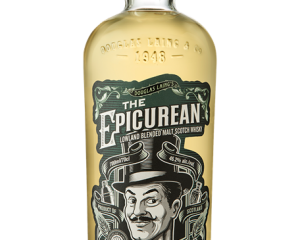 How had the briefs for their wonderfully quirky packagings for Big Peat, Scallywag, The Epicurean, Timorous Beastie etc. come about, I
How had the briefs for their wonderfully quirky packagings for Big Peat, Scallywag, The Epicurean, Timorous Beastie etc. come about, I  wondered. I know the name history of the latter from the Burns poem but who made the name decisions? Cara replied, “It’s a real mix of us all. Big Peat was all Fred’s – he’s very much Fred’s baby. Scallywag was more my brainchild as we wanted a Speyside companion for Big Peat. We have always had Wire Fox Terriers which are fun, feisty characters – it seemed to work with a cheeky, full-bodied sherried Speysider. Rock Island was a Chris project but my packaging brief.” And Epicurean? “Epicurean was all of us – with a distinct look of Fred in there!” Indeed, just compare the moustaches! Timorous Beastie came about as there were Highland stocks to be used too.
wondered. I know the name history of the latter from the Burns poem but who made the name decisions? Cara replied, “It’s a real mix of us all. Big Peat was all Fred’s – he’s very much Fred’s baby. Scallywag was more my brainchild as we wanted a Speyside companion for Big Peat. We have always had Wire Fox Terriers which are fun, feisty characters – it seemed to work with a cheeky, full-bodied sherried Speysider. Rock Island was a Chris project but my packaging brief.” And Epicurean? “Epicurean was all of us – with a distinct look of Fred in there!” Indeed, just compare the moustaches! Timorous Beastie came about as there were Highland stocks to be used too.
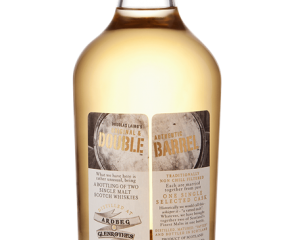 Fred had, indeed, told me that Double Barrel (brilliant label format!) and Big Peat were his ideas. The latter celebrated its tenth anniversary this year. It’s popular in the UK, Scandinavia and Germany. He’s tickled that, in Germany, a tattooist fan has been tattooing the character on to other fans. Fred agrees the label is “disruptive” as he puts it. A number of older contacts didn’t like the cartoon style. The first 600 x 6 bottle cases were bottled as a simple trial – with the brand being “floated” into the market in september 2009 – and that first quantity did eventually sell out which it now does much more quickly. Since then there have been other distinctive cartoon style labels for several brands and it’s good to note that they were amongst the trailblazers in these quirkier, wittier labels, showing good Scotch Whisky doesn’t have to hide behind boring packaging. It’s clever marketing if properly handled – and it is. Notably, all such trailblazers have been independents.
Fred had, indeed, told me that Double Barrel (brilliant label format!) and Big Peat were his ideas. The latter celebrated its tenth anniversary this year. It’s popular in the UK, Scandinavia and Germany. He’s tickled that, in Germany, a tattooist fan has been tattooing the character on to other fans. Fred agrees the label is “disruptive” as he puts it. A number of older contacts didn’t like the cartoon style. The first 600 x 6 bottle cases were bottled as a simple trial – with the brand being “floated” into the market in september 2009 – and that first quantity did eventually sell out which it now does much more quickly. Since then there have been other distinctive cartoon style labels for several brands and it’s good to note that they were amongst the trailblazers in these quirkier, wittier labels, showing good Scotch Whisky doesn’t have to hide behind boring packaging. It’s clever marketing if properly handled – and it is. Notably, all such trailblazers have been independents.
Fred says that in the last 18 months to 2 years he has been easing himself out, becoming Chairman, but still makes frequent office appearances in a business he clearly adores. He travels less but can be found in the markets occasionally performing ambassadorial and problem-solving tasks. He does things “at a more leisurely pace and I like the family involvement”. He still has a nose in the cask selection and blending process at the beginning of each one, though says that more of the final sign-off of expressions is handled by Cara these days. He states what she knows she has gleaned herself from experience elsewhere and constant learning in the family firm. Fred defers to what he regards as ladies’ superior olfactory abilities. On that point, I did ask Cara about the sensory experience whilst expecting both her children wondering if it caused heightened senses. She says she didn’t taste much whisky in both those periods, “I really missed Whisky during those long months. My sense of smell was definitely heightened. It was great from that perspective as I definitely detected a lot more when I was nosing.” That’s a question I keep meaning to ask women blenders in the Scotch industry. I don’t know if it’s already been explored but might make an interesting scientific study if other women blenders worldwide have had the same experience.
Anyway, we digress. I asked Fred to demystify some of the malt ranges for me. The ranges I was more concerned about clarifying are their single malts. In the Exceptional Single Cask collection there are:
Provenance – 6 -12 years old and at 46% abv
Old Particular – mainly 12- 25 years old Years Old (with a few exceptions) and at about 50/51% abv though those under 18 tend to be at 48.4% They have introduced single grain casks into this range too.
Extra Old Particular – largely 25+ years old and cask strength.
Their Remarkable Regional Malts (blended malts) are a major focus for the company and Fred says they are always trying to improve the quality of them. By the way he doesn’t like the “blended malt” description these have to be given now, thinking it confuses consumers even more than the old “vatted malt” term. Much as I supported the change at the time, I think he may have a point here. It’s not a category we’ve explained well to consumers and Fred reckons more of the big guys should get behind blended malts. For clarification to any novices who have joined us, a blended malt is a malt whisky where the whiskies are taken from more than one distillery and blended together. A single malt is whisky from only one distillery.
Let’s look at some of their latest releases. A few new expressions of some brands have emerged in recent months and I was given these to nose and taste back at home. It struck me while trying them that all have great possibilities for vertical or horizontal tastings e.g. trying Batch 1- 5 of The Gauldrons all together, all of the Timorous Beasties from youngest upwards as a group or all the Big Peats, either the Christmas ones or the whole range. Any of these would result in a very happy few hours. I have tried other expressions in these ranges and was careful not to read previous notes first so that new impressions weren’t influenced by those. However, looking back over them afterwards, I can see how the family characteristics of each one persist in my notes.
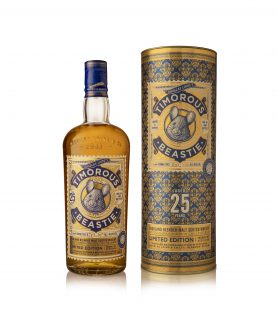 Let’s start with the Timorous Beastie 25 Year Old, a blended Highland malt at 46.8% abv and with no added colour or chill-filtration.
Let’s start with the Timorous Beastie 25 Year Old, a blended Highland malt at 46.8% abv and with no added colour or chill-filtration.
Appearance: A bright, soft, medium gold with brass highlights. Tears are slow, sticky and widely spaced.
Nose: Soft, fruity, a touch of sweet spices and light honey; marshmallows. A slight jasmine note. Some vanilla and soft oak wood too. The honey deepens as it sits with more candied citrus peel and a waft of almond paste. With water, the almonds come out a little more at first as do the vanilla and dried light fruits. A touch of lychee juice which then fades; creaminess. Poised, complex and subtle this has layer after layer. One of those you could inhale for ages and get quite dizzy. Altogether an enticing and beguiling nose.
Palate: Not in the least bit timorous! Surprisingly astringent and forthright on the palate, this has nuts, spice, vanilla and honey as well as toasted oak and some vinous notes – a bit like an oaky chardonnay. There’s even a tiny touch of rubber and a dab of salt. It’s weightier than you might expect from the nose – that sweetness leads you astray – and there’s a great balance of sweet and savoury.
Finish: Long, dry, herbal with sweet notes; some toasted oak and rubber. It’s delicious.
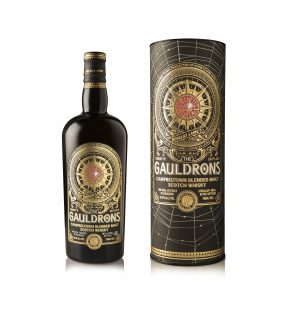
The Gauldrons Batch 5 moves us from Highland to Campbeltown. Also a blended malt this is 46.2% abv, also NCF and no added colour. The packaging features a little spider in a web to remind us of Robert the Bruce being inspired by same in this part of Scotland back in the 14th century.
Appearance: Pale straw gold with a slight tawny tint in the middle.
Nose: Definitely spices; some golden syrup / manuka honey; a touch of smokiness and flowers, indeed, quite a heady scent at first. Some dried apricot aromas and sweet oak wood. With water, there’s more of a spicy cologne note plus citrus zest and spiced tea loaf; fresh, warm madeira cake and apple sponge. Torched meringue sugar notes.
Palate: Slightly luscious and mouth-coating; sweet wood and fruit; warm spices and a hint of ground pepper plus a touch of sea salt. A bit of smoke and liquorice that are more obvious than on the nose. Some tannic characteristics from the oak. Great balance.
Finish: Medium – long; drier than Timorous Beastie; a pepper zing on the tongue and well-integrated smoke.
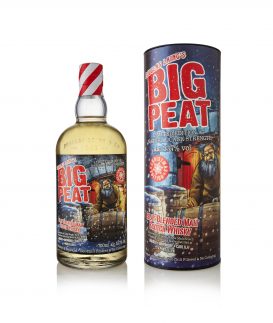 The final tasting sample this time is Big Peat Christmas 2019 edition (53.7% abv, NCF and no added colour) and has us hopping over the sea to discover a blended Islay malt of whiskies from four Islay distilleries. As you might expect there’s plenty of smoke here but not harshly so.
The final tasting sample this time is Big Peat Christmas 2019 edition (53.7% abv, NCF and no added colour) and has us hopping over the sea to discover a blended Islay malt of whiskies from four Islay distilleries. As you might expect there’s plenty of smoke here but not harshly so.
Appearance: Pale straw with fresh lemon juice tints. Sticky, oily tears.
Nose: Smoky; slight sweaty sock and a note like wet wool absorbing bonfire smoke. Milky and malty notes – rather like Horlicks malted drink for those of you familiar with that. Some sweetness and fresh, sea air; ready salted crisps (chips). Not heavy smoke but very definite. With water, it softens the smoke a little plus a bit of char but a sweeter cereal note added. Smoked hard cheese and warm engine oil.
Palate: Quite oily and mouth-coating at first. Heavily toasted barley and wood; char and that hot, melted tarry note that catches in the throat; quite a bit of salt. Savoury spices and brined, smoked ham but also a slight creaminess. This dries the tongue and the cheeks later too.
Finish: Long, dry, smoky, notably salty. This would be great with foods or canapés that have cream cheese in them.
I wondered afterwards which one I would like to spend most time with and it was difficult as all are so good and so different. It came down to a toss of the coin between Timorous Beastie 25 and The Gauldrons Batch 5. There was a tiny amount of each left in the glass so I asked my at-home enthusiast/non-expert to try them and he came down on the side of Timorous Beastie which always has a sweetish nose. In fact, Fred was once asked, “Are you allowed to use that much sugar?” Clearly, that was a man with no whisky education at all!
I asked Fred about the plans for their Glasgow distillery and the purchase some months ago of Strathearn Distillery in Perthshire. He says distilling will be a small part of the whole but feels that to say they are also distillers and bottlers gives added credibility to an already well-regarded company. The distillery in Glasgow (“a zip-wire ride across from the Clydeside Distillery”) is still caught up in planning and environmental discussions which they hope are resolved soon. It will have new offices and a bottling hall and the whisky style will be “more Highland” in character according to Fred, “not light” and certainly not triple-distillation. Strathearn was a means to acquire new whisky stocks they can use going forward and does have financial opportunities from gin and rum currently distilled there. It’s an adjunct to their Glasgow distillery plans, not an alternative and it’s nice to be able to say right now that they are distillers too. Apparently CEO Chris has had his eye on it since about 2014. Presumably part of the strategic focus Cara was mentioning.
What about changes Fred has seen in the industry over the years? He particularly mentioned that when his father started out and in his own early days, business was done at a more personal and personable level, whether selling bottles or buying stocks. Things were settled on a handshake and gentleman’s verbal agreement. He’s pleased to say that old supply agreements and relationships set up by his father with distillers in the 1940’s to 1960’s and beyond still exist today. Fred opines that there is still a certain protective and avuncular attitude towards helping others out and there are a few places where a handshake and eye contact still filter through. In the late 20th century some things changed to be more margin led by importers and they “dealt more with accountants”. I sensed some disapproval here and have to agree in some instances! However, since the turn of the century he detects a return to more old-fashioned confidence in one’s trading partners with fair margins for all.
It’s also getting harder to acquire older casks. Some of the ranges were started to use up what had become “super-expensive stocks”, according to Fred, following the 1990’s financial crisis in the Pacific Rim where the company had much focus. Of course, the worldwide crisis was not that far behind. Fred reckons that with hindsight, they would not have released bottlings of older whiskies so readily at lower prices. I’d say the market has definitely swung away from that though I do find plenty of the Douglas Laing whiskies reasonably priced.
And to the future? They want to focus on building good brand ranges and stamp more authority on the Remarkable Regional Malts which is the fastest growing blended malt range. They will develop the output from their distilleries though they are not intended to be huge production. Given that Cara has two (admittedly very young) children I wondered if there was any hope there for the next generation of whisky producers and whether, in such a close knit unit, if they are aware of what Mummy, Daddy and Grandpa do? Apparently they are aware and are used to the background of whisky and foreign visitors. Cara and Chris’ little girl opines and “waxes lyrical” (proud grandad there) when given something to nose. Their little boy is even younger, recognises peat and refers to Big Peat. This may be due to having some of it rubbed on his gums when teething – or maybe that’s just a tall tale I was told! Certainly better than gripe water. It would, indeed, be lovely if a further generation wanted to take up the business in another 20 years or so but there’s plenty of time.

Meantime, as 2019 draws to a close and you still have time to run out and buy a bottle to celebrate the New Year, I’d recommend seeking out a Douglas Laing & Co. bottling if you haven’t tried one before and certainly any one of the three featured here.
All the best for 2020 to everyone who reads this website and Happy New Year Dramming.
Caroline
Comments